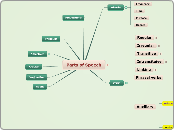Parts of Speech
Usually, we easily identify a word’s part of speech, but a given word’s grammatical category can shift, or one form of the word can differ in meaning from another, in a process called functional variation. For example, note the change in meaning of fly in the following sentences: “He caught a fly” (noun), “He caught a fly ball” (adjective), “He will fly there tonight” (verb), and “He caught the ball on the fly” (part of an adverbial phrase). These and other types of functional variation are described below: 1. Nouns as Adjectives Nouns are frequently employed to modify other nouns (for example, in “light fixture,” “grape jam,” and “railroad track”). However, problems include ambiguous usage, such as in the phrase “box set,” which can mean “a set in a box” (and is therefore better rendered “boxed set”) or “a set of boxes,” and adjective stacking, or employing an excessive series of nouns as adjectives. 2. Adjectives as Nouns The reverse can take place, as when a phrase such as “a hypothetical situation” is truncated to the adjective turned noun hypothetical or when a person or a group is identified, for example, as in “the homeless.” 3. Nouns as Verbs This type of transformation is ubiquitous in the business world and in other jargon-friendly environments, where terms for things such as impact, mainstream, and text become action words. 4. Verbs as Nouns Present participles such as laughing are employed as nouns: In “Who was laughing?” laughing is a verb; however, it’s a noun in “Did you hear that laughing?” (although it would be better to use the noun laughter). 5. Verbs as Adjectives Participles also serve as adjectives. To use the previous example, laughing can also modify a noun, as in “See that laughing girl?” (although one could also write, “See that girl laughing?”). 6. Adjectives as Verbs Such shifts are so rare that the only ones that occur to me are terms I occasionally use in these posts: lowercase and uppercase, as in “Lowercase job titles after a name,” in which lowercase refers to an action involving job titles, rather than describing a type of treatment of a job title. 7. Prepositions as Adverbs When one refers, for example, to “calling up reserves” or “casting off from the dock,” one is using idiomatic phrasal verbs to describe how calling or casting occurs, though some phrasal verbs are merely figurative; “calling up,” for example, involves no upward movement, while “casting off” literally results in one no longer being on the dock. 8. Conjunctions as Prepositions In rare cases, a conjunction can serve as a preposition, as when but, which usually functions as a conjunction, as in “I was there, but I didn’t see you,” is employed as a synonym for except, as in “Everyone but you has agreed.” 9. Various Parts of Speech as Interjections Most parts of speech can serve as an interruptive or exclamatory term, including nouns (“Dude!”), pronouns (“Me!), verbs (“See?”), adjectives (“Wonderful!”), and adverbs (“Slowly!”).
Adverbs
Words, phrases or clause that modify or describe a verb, adjective, or other adverb and answer questions as:place- where?time- when?manner- how ?purpose- why?How much?frequency-How often?duration- How long?To what extent or degree?
Manner
Place
Frequency
Time
Purpose
Degree
Verbs
Verbs are words that describe action or being. Verbs can be action verbs (transitive and non-transitive), being verbs, linking verbs or helping verbs.VERB FORMS ?
Regular
The main verbs are classified as regular verbs and irregular verbs. They can be identified by how their past tense and past participle are formed.The past tense and past participle of regular verbs end in –d or –ed.•Present tense - touch, kill, pass, rub, stop•Past tense - touched, killed, passed, rubbed, stopped•Past participle - touched, killed, passed, rubbed, stopped
Irregular
The past tense and past participle of irregular verbs do not follow the above pattern of grammar. They do not end in –d or –ed..
Transitive
A transitive verb must have an object. Without an object, it does not convey a clear meaning.
Intransituive
An intransitive verb does not have an object. Without an object, the meaning is not affected.
Linking
We can identify a linking verb by replacing it with to be and see if it makes sense.•He feels fine. = He is fine. (The sentence makes sense, so the verb is a linking verb.)•He feels the fine sand of the beach. = He is the fine sand of the beach? (The verb is not a linking verb.) Some common linking verbs are appear, become, feel, grow, look, seem, smell, sound, taste.
Phrasal verbs
Auxiliary
Primary
DO
Subtopic
Subtopic
Have
Subtopic
Subtopic
Be
Modal
Modal verbs do not change their forms when used with other verbs such as to show number. They have no –s form for the third person singular, no –ing form or past participle form.Example: I can go. She can go. They can go.Modal verbs always come before the other verbs. We use them to express possibility, ability, necessity, permission, intention, obligation, wishes, etc., and each of them can express more than one of these ideas. The following are modal verbs:1. CAN and COULD2. MAY and MIGHT3. WILL and WOULD4. SHALL and SHOULD5. MUST7. OUGHT TO and
Prepositions
Pronouns
Adjectives
Adjectives modify a noun or pronoun. Some people say they “describe” the specific noun or pronoun.Adjectives often answer the following questions:◾Which one◾What kind?◾How many?
